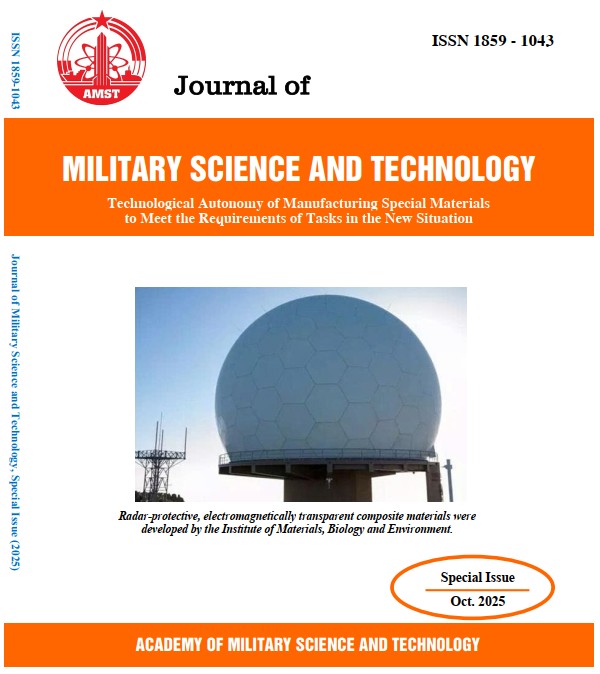Enhanced photocatalytic performance of porous MoS2 structures for methyl orange degradation in simulated sunlight
96 viewsDOI:
https://doi.org/10.54939/1859-1043.j.mst.IMBE.2025.88-94Keywords:
MoS2 nanoflowers; Photocatalysis; Methylene orange; Reactive oxygen species; Solar irradiation.Abstract
In this study, porous MoS2 nanoflowers (NFs) were synthesized using a simple hydrothermal method and tested for their photocatalytic efficiency in degrading methyl orange (MO) under simulated sunlight. The MoS2 NFs possess a hierarchical structure formed by ultrathin nanosheets, which provide a large surface area and active edge sites, enhancing light absorption and facilitating efficient charge separation. Photocatalytic experiments demonstrated an impressive degradation efficiency of more than 60% for MO dyes after 120 minutes of reaction with a degrading rate of 2.51 x 10-2 min-1. The enhanced photocatalytic performance is attributed to the high crystallinity, a large surface-to-volume ratio, and efficient charge carrier dynamics provided by the porous MoS2 nanoflower structure. These findings suggest that MoS2 nanostructures are highly promising as efficient and stable photocatalysts for practical applications in wastewater treatment under solar irradiation, offering potential for sustainable environmental remediation.
References
[1]. Forgacs, E., Cserháti, T., Oros, G., "Removal of synthetic dyes from wastewaters: a review", Environmental International, 30(7), 953–971 (2004). DOI: https://doi.org/10.1016/j.envint.2004.02.001
[2]. Robinson, T. et al., "Remediation of dyes in textile effluent: a critical review on current treatment technologies with a proposed alternative", Bioresource Technology, 77(3), 247–255 (2001). DOI: https://doi.org/10.1016/S0960-8524(00)00080-8
[3]. Fujishima, A., Honda, K., "Electrochemical photolysis of water at a semiconductor electrode", Nature, 238, 37–38 (1972). DOI: https://doi.org/10.1038/238037a0
[4]. Ahmed, M. A., Mahmoud, S. A., Mohamed, A. A., "Interfacially engineered metal oxide nanocomposites for enhanced photocatalytic degradation of pollutants and energy applications", RSC Advances. DOI: https://doi.org/10.1039/D4RA08780A DOI: https://doi.org/10.1039/D4RA08780A
[5]. Sivaranjani, P. R., Janani, B., Thomas, A. M., Raju, L. L., Khan, S. S., "Recent development in MoS2-based nano-photocatalyst for the degradation of pharmaceutically active compounds", Journal of Cleaner Production, 352, 131506 (2022). DOI: https://doi.org/10.1016/j.jclepro.2022.131506 DOI: https://doi.org/10.1016/j.jclepro.2022.131506
[6]. Yan, X. et al., "3D layered nano-flower MoSx anchored with CoP nanoparticles form double proton adsorption site for enhanced photocatalytic hydrogen evolution under visible light driven", International Journal of Hydrogen Energy, 45, 2578–2592 (2020). DOI: https://doi.org/10.1016/j.ijhydene.2019.11.227
[7]. Yan, Y., Xia, B., Ge, X., Liu, Z., Wang, J.-Y., Wang, X., "Ultrathin MoS2 Nanoplates with Rich Active Sites as Highly Efficient Catalyst for Hydrogen Evolution", ACS Applied Materials & Interfaces, 5, 12794–12798 (2013). DOI: https://doi.org/10.1021/am404843b DOI: https://doi.org/10.1021/am404843b
[8]. Wang, Q. H., Kalantar-Zadeh, K., Kis, A., Coleman, J. N., Strano, M. S., "Electronics and optoelectronics of two-dimensional transition metal dichalcogenides", Nature Nanotechnology, 7, 699–712 (2012). DOI: https://doi.org/10.1038/nnano.2012.193
[9]. Sun, Y., Zhang, Y., Zheng, S., Wang, C., "Facile synthesis of flower-like MoS₂ nanostructures and their application in photocatalytic degradation of methylene blue", Journal of Materials Science, 51, 10362–10371 (2016).
[10]. Yu, X., Zhang, H., Cui, H., Yang, Y., "Hydrothermal synthesis of porous MoS₂ nanoflowers for enhanced visible-light photocatalytic activity", Materials Letters, 142, 276–279 (2015).
[11]. Xiao, X., Wang, Y., Cui, B., Zhang, X., Zhang, D., Xu, X., "Preparation of MoS2 nanoflowers with rich active sites as an efficient adsorbent for aqueous organic dyes", New Journal of Chemistry, (n.d.). DOI: https://doi.org/10.1039/D0NJ00129E DOI: https://doi.org/10.1039/D0NJ00129E
[12]. Ghamarpoor, R., Fallah, A., Jamshidi, M., "A Review of Synthesis Methods, Modifications, and Mechanisms of ZnO/TiO2-Based Photocatalysts for Photodegradation of Contaminants", ACS Omega, 9, 25457–25492 (2024). DOI: https://doi.org/10.1021/acsomega.3c08717 DOI: https://doi.org/10.1021/acsomega.3c08717
[13]. Zhang, X., et al., "Photocatalytic degradation of methyl orange by MoS₂ nanosheets under visible light irradiation", Applied Catalysis B: Environmental, 147, 229–235 (2014). DOI: https://doi.org/10.1016/j.apcatb.2013.09.031 DOI: https://doi.org/10.1016/j.apcatb.2013.09.031
[14]. Zhang, H., et al., "Visible-light-driven photocatalytic degradation of organic pollutants by few-layer MoS₂ nanosheets", Nanotechnology, 24(28), 285706 (2013).
[15]. Liu, S., et al., "Morphology-dependent photocatalytic activity of MoS₂ nanostructures", Materials Letters, 276, 128192 (2020). DOI: https://doi.org/10.1016/j.matlet.2020.128192
[16]. Wang, C., et al., "Charge separation in 2D MoS₂-based composites for photocatalysis", Chemical Engineering Journal, 420, 129702 (2021).
[17]. Yang, X., Wen, L., et al., "Hydrothermal synthesis of MoS2 nanoflowers and its rapid adsorption of tetracycline", Solid State Sciences, 133, 107014 (2022). DOI: https://doi.org/10.1016/j.solidstatesciences.2022.107014
[18]. Tien, T.-M., Chao-Hsiang, et al., "Photocatalytic Degradation of Methyl Orange Dyes Using Green Synthesized MoS2/Co3O4 Nanohybrids", Catalysts, 12(11), 1474 (2022). DOI: https://doi.org/10.3390/catal12111474 DOI: https://doi.org/10.3390/catal12111474
[19]. Zhang, H., Cong, L., et al., "Impact of CTAB on morphology and electrochemical performance of MoS2 nanoflowers with improved lithium storage properties", Journal of Materials Science: Materials in Electronics, 29, 3631–3639 (2018). DOI: https://doi.org/10.1007/s10854-017-8293-4 DOI: https://doi.org/10.1007/s10854-017-8293-4







